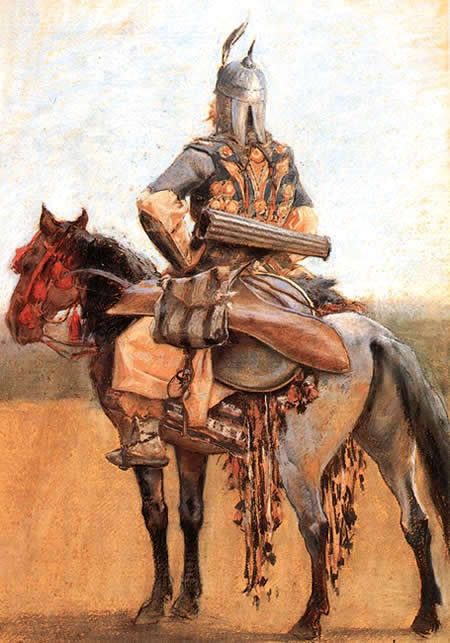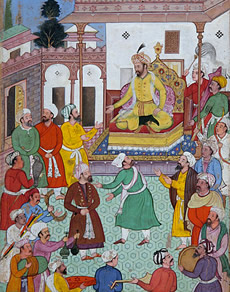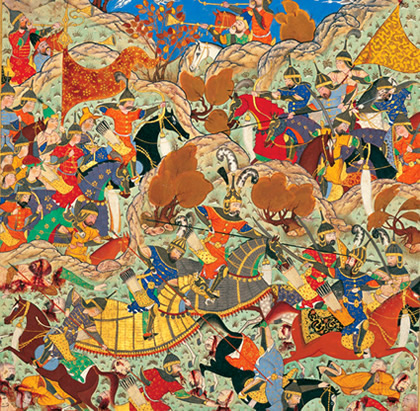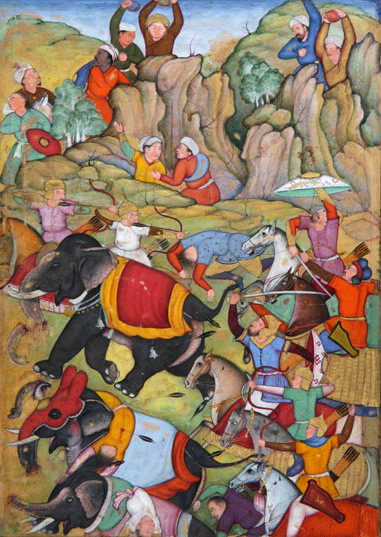 |
| Christian States of Spain |
When the Moors from
Morocco invaded Spain in 711, they easily managed to capture most of the Iberian Peninsula with the exception of the area around the Asturian Mountains in the north. When they did get around to attacking that region in 718, the Christians defeated the Moors at the Battle of Covadonga, near Asturias.
The Moors decided to leave that part of Spain unconquered, marking what became the first battle in what the Spanish called the “Reconquista,” or Reconquest of Spain for Christendom. Over the next centuries several Christian kingdoms emerged in Spain, notably Asturias, León, Castile, Aragon, and Navarre.
These gradually expanded and eventually managed to defeat the Moors using their alliances. They ejected them from the
Iberian Peninsula in 1492, when Isabella, heir to the throne of Castile, and Ferdinand II, king of Aragon, captured Granada, the last Muslim possession on the peninsula.
Kingdom of Asturias The kingdom of Asturias was, in origin, a
Visigoth kingdom of Spain created by Pelayo (Pelagius), a grandson of King Chindaswinth, who had been defeated by the Moors. Pelayo established his capital at Cangas de Onis, securing his independence with a victory at the
Battle of Covadonga. The Moors, rather than sending more soldiers into Asturias, headed into France and in 732 were defeated at the Battle of Tours.
For the next century the Moors were on the defensive and this allowed Pelayo and his successors to rebuild their strength. Pelayo’s son, Favila, became king on his father’s death in 737 but died two years later in a boar hunt. He had no son so his brother-in-law was proclaimed King Alfonso I.
He enlarged the kingdom of Asturias by annexing Galicia in the west, and León in the south. He also extended his lands in the east to the borders of Navarre. When Alfonso died, his cruel son Fruela I came to the throne. One of Fruela’s first acts was to kill his own brother, Bimarano, who he thought wanted the throne. After reigning for 11 years, Fruela was murdered on January 14, 768, and was succeeded by his cousin Aurelius (son of Alfonso’s brother Fruela).
He was, in turn, succeeded by Silo, a nephew, who had married Alfonso I’s daughter. Aurelius had managed to prevent the Moors from attacking by paying them tribute, and all that is known about Silo is that he moved the kingdom’s capital from Cangas de Onis to Pravia. This period coincided with Charlemagne’s invasion of Spain, and his capture of Barcelona.
Silo’s successor, Mauregato, was an illegitimate son of Alfonso I (his mother allegedly being a slave) (r. 783–788) and was alleged to have offered 100 beautiful maidens annually as tribute to the Moors. The next king, Bermudo I, a brother of Aurelius, had been ordained deacon and reluctantly accepted the position as king, abdicating three years later and allowing Alfonso II “The Chaste,” a son of Fruela I, to become king.
Initially people were worried that Alfonso might try to avenge the murder of his father—instead he ruled for 51 years. He had been married to Berta, said to have been a daughter of
Pepin, king of the Frankish tribe, but they had no children as he had taken a vow of celibacy.
During his long reign he stabilized the country’s political system amd attacked the Moors, defeating them near the town of Oviedo, which they had recently sacked. Alfonso II was so impressed by the beauty of Oviedo that he moved his court there and proclaimed it his capital. It was to remain capital of the kingdom of Asturias until 910, when León became the new capital.
Work began on the construction of the Oviedo Cathedral, where Alfonso II was eventually buried. Alfonso’s main achievement was that he conquered territory from the Moors, moving the reach of his Christian kingdom into the edges of central Spain. The Moorish king Abd ar-Rahman II (r. 822–852) was, however, able to check the advances of Alfonso, drive back the Franks, and stop a rebellion by Christians and Jews in Toledo.
The next king of Asturias was Ramiro I, a son of Bermudo I. He began his reign by capturing several other claimants to the throne, blinding them, and then confining them to monasteries. As a warrior he managed to defeat a Norman invasion after the Normans had landed at Corunna, and also fought several battles against the Moors. His son, Ordono I, became the next king and was the first to be known as king of Asturias and of León.
Ordono extended the kingdom to Salamanca and was succeeded by his son Alfonso III “The Great.” Alfonso III reigned for 44 years (866–910) and during that time consolidated the kingdom by overhauling the bureaucracy and, then fought the Moors. He managed to enlarge his lands to cover the whole of Asturias, Biscay, Galicia, and the northern part of modern-day Portugal. The southern boundary of his kingdom was along the Duero (Douro) River.
Kingdom of León Alfonso had three feuding sons who plotted against each other and then against their father. To try to placate them all, Alfonso divided his kingdom into three parts. Garcia became king of León, Ordono became king of Galicia, and Fruela became king of Oviedo (ruling Asturias). This division was short-lived as wars among the young men resulted in all the lands eventually coming together under one ruler.
García only reigned for four years before he died, without any children. Ordono II ruled in Galicia before dying 14 years later and eventually Fruela II “The Cruel,” Alfonso III’s fourth son, who had outlived the others, reunited the kingdom in 924. However he died of leprosy in the following year, with Ordono II’s son’s becoming King Alfonso IV.
He did not want to rule and abdicated in order to spend the rest of his life as a monk. This allowed Alfonso IV’s brother to become King Ramiro II. Soon after this, Alfonso tried to regain the throne, only to be taken by his brother, blinded, and left at the Monastery of St. Julian, where he died soon afterward.
Ramiro II was succeeded by his elder son, Ordono III, and then by a younger son, Sancho I “The Fat.” There were two years when Ordono IV “The Wicked,” a son of Alfonso IV, was king, but then Sancho I’s only son became King Ramiro III. He was five when he became king and the Normans decided to attack again, destroying many coastal towns. Eventually he abdicated and allowed his cousin, Bermudo II, son of Ordoo III, to become king.
It was during the reign of Bermudo II that the Moors attacked and managed to get as far as León. When Bermudo II died in 999, his son Alfonso V was only five, and Don Melindo González, count of Galicia, became regent. In his 20s Alfonso V led his armies into battle against the Moors, recaptured much of León, but was killed in battle with the Moors at Viseu in Portugal, on May 5, 1028.
His only son, Bermudo III, was 13 and during his nine year reign faced more threats from the neighboring Christian kingdom of Castile. In 1037 he was killed at the Battle of the River Carrion fighting King Ferdinand I of Castile, and the kingdom of León, as it was then known, was absorbed into Castile.
Kingdom of Castile and Granada The kingdom of Castile began as a dependency of León and was controlled by counts. However in 1035 Ferdinand I “The Great” was proclaimed king of Castile and two years later after defeating and killing Bermudo III, became king of Castile and León, ruling for the next 27 years.
These new kings saw themselves as lineal descendants of the heritage of Asturias, even if not by blood. When Ferdinand I died he divided his lands among his children and Sancho received Castile, Alfonso received León and Asturias, García was given Galicia and northern Portugal, his daughter Urraca was given Zamora, and Elvira was given Toro.
This was meant to end squabbling by them but only ended up with much fighting. At this time, a nobleman, Rodrigo Díaz de Bibar, emerged as the great Spanish pahlawan El Cid. Interestingly he later tried to set up his own kingdom of Valencia, which ended in his death. Eventually Alfonso ruled all the lands as Alfonso VI “The Brave,” king of Castile.
Alfonso VI launched a number of attacks on the Moors but most of these were overshadowed by the efforts of El Cid. In 1085 the Christians were able to capture the city of Toledo, and Alfonso reigned until his death in June 1109 at the age of 70. He had five or six wives. His daughter Urraca succeeded Alfonso VI. She married first Raymond, count of Burgundy, and later Alfonso I, king of Aragon.
Her successor was Alfonso VII (r. 1126–1157), titling himself as “Emperor of All Spain.” When he died his lands were divided between his eldest son, Sancho III “the Desired,” who was given Castile; and his second son, Ferdinand II, who was given León.
Sancho III only reigned for a year and his only surviving son became Alfonso VIII, r. 1158–1214. In 1212 he defeated the Moors at the battle of Las Navas de Tolosa, giving Castile control over central Spain. When he died, Henry I, his youngest but only surviving son, succeeded him. He died and was succeeded as king of Castile by his nephew Ferdinand III.
Meanwhile in León, Ferdinand II had reigned for 31 years, and when he died in 1188, his brother, Alfonso IX, succeeded him. Alfonso IX’s first wife Teresa, from whom he was divorced, was later canonized as Saint Teresa in 1705. His eldest surviving son with his second wife was Ferdinand, who had already become king of Castile. When Alfonso IX died in 1230, the kingdoms of Castile and León were reunited.
Ferdinand III embarked on a series of wars against the Moors, managing to capture the cities of Córdoba (1236), Jaen (1246), and Seville (1248). With the capture of Seville, the “Reconquista” was almost complete—the Moors held only the city of Granada. The forces of Ferdinand were unable to take that city, although the emir of Granada did acknowledge his overlordship.
Ferdinand III also founded the University of Salamanca, died on May 30, 1252, and was buried in Seville Cathedral. In 1671 Pope Clement X canonized him, and he became St. Ferdinand (San Fernando). Ferdinand’s son, Alfonso X, had two titles, “The Wise,” and “The Astrologer.”
During his reign he codified the laws, wrote poems, and had a large number of scholars produce a great chronicle of Spanish history. One of his advisers, Jehuda ben Moses Cohen, wrote that the king was someone “in whom God and placed intelligence, and understanding and knowledge above all princes of his time.”
He was also elected as King of the Romans in 1257, renouncing the title of Holy Roman Emperor in 1275. However Alfonso X was faced with a dynastic succession crisis. His eldest son, Ferdinand de la Cerda, died in 1275, leaving two young sons, Alfonso X did not want a young boy on the throne so nominated as his successor his second son, Sancho. Ferdinand’s wife championed the cause of her two boys, and Alfonso X’s wife sided with her.
The conflict continued when the French—Ferdinand’s wife was a French princess—declared war on Sancho, who had the support of the Spanish parliament, the Cortes. War seemed inevitable, but when news arrived that Sancho was ill, Alfonso died of grief and despair.
Sancho IV “The Brave” became the next king, his illness being not as serious as was first thought, and after reigning for 11 years, he was succeeded by his son Ferdinand IV “The Summoned,” who was only nine when he became king—his mother ruled ably as regent. Little of note happened during Ferdinand IV’s reign and he gained his title from sentencing to death two brothers who had been accused of murdering a courtier.
They went to their execution protesting their innocence and “summoned” Ferdinand to appear at God’s court of judgment in 30 days. As Ferdinand was only 26 years old at the time he was unconcerned, but on the 30th day after the execution his servants found him dead in bed.
His one-year-old son, Alfonso XI “The Just,” became the next king and in 1337, when he was 13 years old, attacked the Moors of Granada. At the Battle of Río Salado on October 30, 1340, the Spanish, supported by the Portuguese, defeated a Moorish army. It was said to have been the first European battle where cannons were used. Alfonso XI reigned until 1350 when he was 39.
Alfonso was married to Maria of Portugal but spent most of his reign with Leonor de Guzmán, a noble woman who had recently been widowed. Alfonso and Leonor had a large family but when Alfonso died, Leonor was arrested on orders of the queen and taken to Talavera, where she was strangled. The next king was the son of Alfonso and Maria, Pedro I “The Cruel,” who reigned from 1350 until 1366.
During the reign of Pedro I he also married Blanche of Bourbon, cousin of the king of France, but fell in love with Maria de Padilla. Initially Pedro appointed Maria’s friends and family to positions of influence, but some nobles forced the dismissal of supporters and relatives of Maria.
In 1355 he had four of these noblemen stabbed to death, and apparently blood splattered over the dress of his wife, earning Pedro his title “The Cruel.” In 1366 he was deposed by his half brother Henry II of Trastamara, “The Bastard,” but managed to oust Henry and returned as king in the following year, spending the next two years in battles with his half brothers, and assisted by the English led by Edward the “Black Prince.”
These events formed the backdrop of the French novel Agenor de Mauleon (1846) by Alexander Dumas. Eventually Pedro was murdered and
Henry II was restored to the throne. Over the next 10 years, until Henry died, attempts were made, ultimately successful, to prevent John of Gaunt from invading Spain.
Henry II’s only legitimate son, was John I, 21 years old, and he became king when his father died. Some 11 years later, while watching a military exercise, John I fell from his horse and was killed. His 11-year-old son, Henry III “The Infirm,” became the next king. When he died in December 1406, his one-year-old son was proclaimed John II. When he was 13 years old, the Cortes declared the teenager to be “of age,” and John II ruled in his own right.
The king had many favorites, one of whom was Don Alvaro de Luna, who later writers suggested was a boyfriend of the young king. John II reigned until his death in 1454, was succeeded by his son, Henry IV, who reigned until 1474. He had a daughter and before Henry IV died, the heiress, Isabella, married Ferdinand of Aragon, uniting Christian Spain.
Kingdoms of Aragon and Navarre The royal House of Aragon, in northeastern Spain, traces its origins back to Ramiro I (r. 1035–1063). His father, Sancho III, king of Navarre, had left him Aragon, as Ramiro was illegitimate. Ramiro was a warrior prince and quickly extended his lands, even briefly taking part in forays into the land of his half brother Garcia III, who had inherited the rest of Navarre.
In a war with the Moorish emir of Saragossa over tribute, Ramiro was killed in battle on May 8, 1063. Ramiro’s successor was his eldest son, Sancho I, who managed to recapture lands from the Moors, pushing the boundaries of Aragon to the north bank of the river Ebro. In 1076 when his cousin, the king of Navarre, died, Sancho succeeded to the throne of Navarre.
In June 1094 Sancho was killed during the siege of Huesca. His son and successor, Pedro I, then became king of Aragon and Navarre, carrying on the siege of Huesca for another two years. In 1096 he defeated a large Moorish army and its Castilian allies, at the Battle of Alcoraz, with help, legends state, from St. George. Pedro’s two children died young, and in grief both he and his wife died soon afterward.
Pedro was succeeded by his brother Alfonso I “The Warrior.” Having no children he was succeeded by his younger brother, Ramiro II “The Monk.” Ramiro was only king for three years, abdicating to spend the remaining 10 years of his life in a monastery.
His only child, Petronilla, became queen, when she was one year old. When she turned 15 in 1151, she married Ramon Berenguer IV, count of Barcelona. Twelve years later she abdicated the throne in favor of her son Alfonso II (r. 1163–96).
His eldest son and successor was Pedro II, who was alleged to have kept scandalous company with many women. With the outbreak of the
Albigensian Crusade in France, and the persecution of the Cathars in southern France, Pedro II led his army into the region to demonstrate the historical ties of Aragon to the region.
He tried to stop the carnage that was taking place around Carcassone and urged the pope to recognize the area as a part of Aragon, not France, which would have ended the crusade. He failed and on September 13, 1213, at the Battle of Muset, was killed in battle with the crusaders led by Simon de Montfort.
Pedro’s son James I “The Conqueror” was only five when he succeeded his father. After a terrible regency, James took control and led his armies in taking the Balearic Islands (1229–35), conquering Valencia from the Moors in 1233–45, and also in the campaign against Murcia in 1266. When James died his son, Pedro III, succeeded him, leading his armies against the Moors.
He had a claim to the kingdom of Sicily through his wife and invaded the island in 1282, earning the title “The Great.” He was badly injured in the eye during fighting with the French and died soon afterward to be succeeded by his son Alfonso III “The Do-Gooder.” This interesting title came from the fact that he granted his subjects the right to bear arms.
His brother and successor James II “The Just” conquered more land from the Moors and was in frequent disputes with the papacy. In 1310 he conquered Gibraltar, and possibly to placate Pope Clement V, two years later he suppressed the Order of the Knights Templar.
James II was succeeded by his son Alfonso IV “The Debonair” or “The Good.” Most of his reign was spent in disputes over the islands of Corsica and Sardinia, which were captured by the Genoese. His son and successor, Pedro IV, held a huge coronation, apparently with as many as 10,000 guests, and earned the title “The Ceremonious.”
He managed to lead his army into Sicily, which he recaptured, and when he died in 1387, his feeble son John I succeeded to the throne. His wife, Iolande de Bar, was actually in control of the kingdom. John died after being gored by a boar during a hunt, and his younger brother Martin “The Humane” became king.
It was during his reign that the famous santo cáliz was transferred to Valencia Cathedral, where it is still revered by many as the Holy Grail. It was said that St. Peter took it from the Holy Land to Rome, and it was taken to Valencia. Martin lost the throne of Sicily and when he died in 1410, there was a brief interregnum until Ferdinand I “The Just” was proclaimed king.
Ferdinand I was the son of John I and was elected king by the nobles. When Ferdinand I died in 1416, after reigning for just four years, his eldest son, Alfonso V “The Magnanimous,” became king. There was a plot to overthrow him, and he refused to hear the names of the conspirators, allowing them to go unpunished.
He spent much of his time and energy in his possessions in Italy: Naples and Sicily. When he died, his lands in Spain went to his brother John, who had been king of Navarre, and he became king of Aragon and Navarre. His Italian lands went to his illegitimate son Ferdinand. John II reigned from 1458 until 1479.
His greatest achievement was arranging the marriage of his son, Ferdinand, to Isabella, heir to the throne of Castile. They were married in 1469 at Valladolid. When John died on January 19, 1479, the Christian kingdoms of Spain were united with Ferdinand and Isabella as joint rulers. In 1492 the armies of
Ferdinand and Isabella finally took Granada, the last Moorish part of the Iberian Peninsula, ending the “Reconquista.”



















